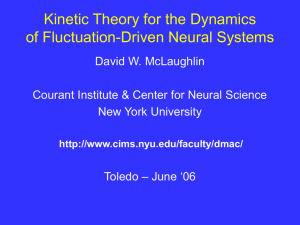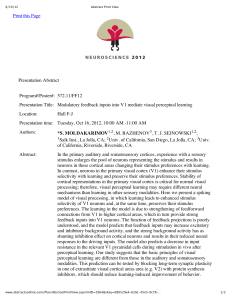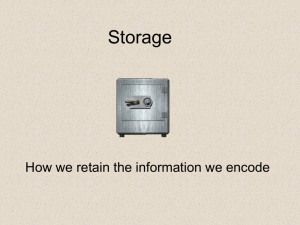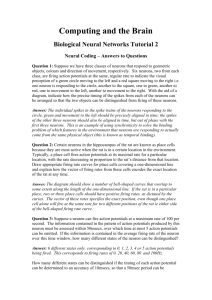Coarse-Grained Modeling of Spatio-Temporal Cortical Activity in V1: Fluctuation Driven Dynamics
advertisement
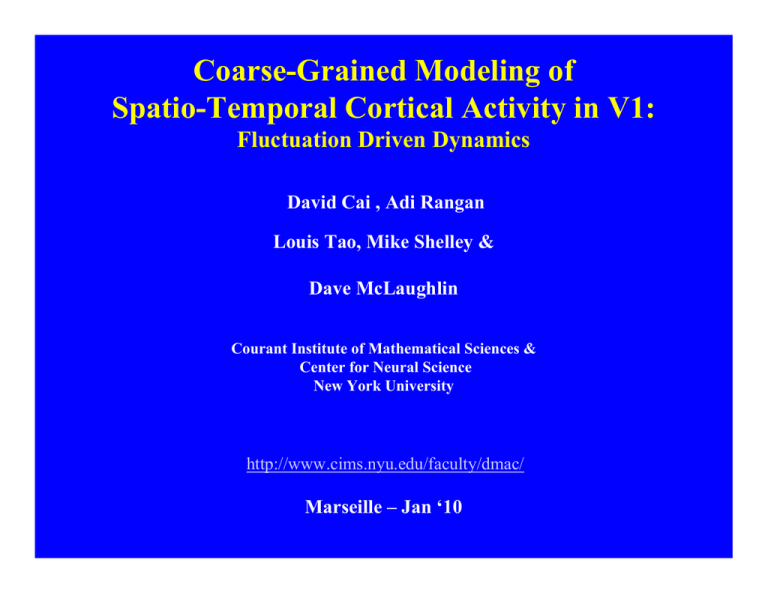
Coarse-Grained Modeling of
Spatio-Temporal Cortical Activity in V1:
Fluctuation Driven Dynamics
David Cai , Adi Rangan
Louis Tao, Mike Shelley &
Dave McLaughlin
Courant Institute of Mathematical Sciences &
Center for Neural Science
New York University
http://www.cims.nyu.edu/faculty/dmac/
Marseille – Jan ‘10
Background
For the past decade, we have been studying the
“front end” of the visual system
V1 -- the primary visual cortex
Through large scale computational modeling
Visual Pathway: Retina --> LGN --> V1 --> Beyond
The “primary visual cortex (V1)” is a “layered structure”,
with O(10,000) neurons per square mm, per layer.
Our Model (~16mm2, 64 pinwheels)
5x105 coupled Integrate & Fire (I&F), conductance-based, point neurons
τ
dVE (x)
= − [VE (x) − ε R ] − g E E ( x, t ) [VE (x) − ε E ] − g EI ( x, t ) [V (x) − ε I ]
dt
(
)
(
g EE ( x, t ) = FLGN (x) + f noise (x) + S S EE ∑ K S x ,x ' ∑ GE S t − T f ,l x ' + S L EE ∑ ' K L x ,x ' ∑ GE L t − T f ,l x '
l
x'
x'
Local
Spontaneous: FLGN=0
)
l
Long Rang
Conductance Time Course:
…
…
…
(
G t − Tf l
VT
)
Tf l
t
εR
Nonlinearity from spike-threshold:
Whenever V(x,t) = VT, the neuron "fires", spike-time T f l recorded,
and V(x,t) is reset to R ,
held at R for an absolute refractory period τ ref .
ε
ε
Local:
G S (t ) =
f
σd −σr
⎛
⎡ t ⎤
⎡ t ⎤⎞
⎜⎜ exp ⎢ − ⎥ − exp ⎢ − ⎥ ⎟⎟ θ ( t )
⎣ σr ⎦⎠
⎣ σd ⎦
⎝
Long-range:
GE L ( t ) = (1 − Λ ) GAMPA ( t ) + ΛGNMDA ( t )
AMPA: ~5ms
NMDA: ~80-100ms
Summary Description of the Model
•
•
•
Large scale, single layer model (16 mm^2; 64 orientation pinwheels)
Fast integrator (advance in computational technology)
Conductance based, I&F point neurons
– O(10^5) neurons
– Simple and complex cells
– Excitatory & Inhibitory neurons
•
Local connections
–
–
–
–
•
Isotropic
Inhibition: GABAa;
Excitation: AMPA & NMDA;
Excitatory length scales longer than (comparable with) inhibitory
Long range connections
– Excitatory
– NMDA & AMPA
– Orientation Specific
•
All connections sparse
Network Architecture
Tiling of Orientation Hypercolumns
Lateral Connections and Orientation -- Tree Shrew
Bosking, Zhang, Schofield & Fitzpatrick
J. Neuroscience, 1997
Short Range (Excitatory and inhibitory):
Long Range, Excitatory Connections:
⎛ x − x'
⎜− 2
exp
⎜ σ EE
2πσ 2 EE
⎝
σ EE , σ EI 100 − 300μ m
1. Gaussian, σ L 1500μ m
2. NMDA +AMPA
3. Orientation-specific, Anisotropy
K S x,x ' =
1
2
⎞
⎟
⎟
⎠
Summary Performance of the Model
• Not balanced, but over inhibited, with large conductances
• Feed For’d Network, primarily,
– But with strong lateral recurrent connections
• Intermittant desuppressed state (IDS)
– High gain, but “pre-hysteresis” regime
– In which fluctuations dominate
• One model, when in (from) IDS state, reproduces in detail
– Linear/nonlinear behavior of simple/complex cells
– Orientation selectivity
– Voltage sensitive dye observations
• Spontaneous activity
• Response to line motion illusion stimuli
Coarse-Grained Asymptotic
Representations
Needed for computational efficiency
“Scale-Up” -- to
• Larger lateral area
• Multiple layers
• All methods for coarse-graining begin with
First, tile the cortical layer with coarse-grained (CG) patches
Most Common Coarse-Grained
Reduction
Average firing rate models
[Cowan & Wilson (’72); ….;
Shelley & McLaughlin(’02)]
Average firing rate of an excitatory (inhibitory) neuron,
within coarse-grained patch located at location x in the
cortical layer:
mσ(x,t), σ = E,I
Such mean-field approaches will never capture fluctuation
driven dynamics – dynamics driven by temporal
fluctuations
Cortical networks have a very
“noisy” dynamics
• Strong temporal fluctuations
• On synaptic timescale
• Fluctuation driven spiking
Experiment Observation
Fluctuations in Orientation Tuning (Cat data from Ferster’s Lab)
Ref:
Anderson, Lampl, Gillespie, Ferster
Science, 1968-72 (2000)
Fluctuation-driven
spiking
(very noisy dynamics,
on the synaptic time scale)
Solid:
average
( over 72 cycles)
Dashed: 10 temporal
trajectories
•
To accurately and efficiently describe these networks requires that
temporal fluctuations be retained in a coarse-grained representation.
•
“Pdf ” representations –
ρσ(v,g; x,t), σ = E,I
will retain temporal fluctuations.
•
But will not be very efficient numerically
•
Needed – a reduction which retains temporal
1.
2.
•
Means &
Variances
Kinetic Theory provides this representation
Ref: Cai, Tao, Shelley & McLaughlin, PNAS, pp 7757-7762 (2004)
Kinetic Theory begins from
PDF representations
ρσ(v,g; x,t), σ = E,I
• Knight & Sirovich;
• Nykamp & Tranchina, Neural Comp (2001)
• Haskell, Nykamp & Tranchina, Network (2001) ;
• For convenience of presentation, I’ll sketch the derivation
a single CG patch, with 200 excitatory Integrate & Fire
neurons
• The results extend to interacting CG cells which include
inhibition – as well as different cell types such as “simple”
& “complex” cells.
• First, replace the 200 neurons in this CG patch by an
equivalent pdf representation
• Then derive from the pdf rep, kinetic theory
• N excitatory neurons (within one CG cell)
• Random coupling throughout the CG cell;
• AMPA synapses (with a short time scale σ)
τ ∂t vi = -(v – VR) – gi (v-VE)
σ ∂t gi = - gi + Σl f δ(t – tl) +
(Sa/N) Σl,k δ(t – tlk)
vi (tik) = 1; vi (t = tik + ) = 0
ρ(g,v,t) ≡ N-1 ∑i=1,N E{δ[v – vi(t)] δ[g – gi(t)]},
Expectation “E” over Poisson spike train { tl }
τ ∂t vi = -(v – VR) – gi (v-VE)
σ ∂t gi = - gi + Σl f δ(t – tl) + (Sa/N) Σl,k δ(t – tlk)
Evolution of pdf -- ρ(g,v,t): (i) N>>1; (ii) the total input to each
neuron is (modulated) Poisson spike trains.
∂t ρ = τ-1∂v {[(v – VR) + g (v-VE)] ρ} + ∂g {(g/σ) ρ}
+ ν0(t) [ρ(v, g-f/σ, t) - ρ(v,g,t)]
+ N m(t) [ρ(v, g-Sa/Nσ, t) - ρ(v,g,t)],
ν0(t) = modulated rate of incoming Poisson spike train;
m(t) = average firing rate of the neurons in the CG cell
= ∫ J(v)(v,g; ρ)|(v= 1) dg,
and where J(v)(v,g; ρ) = -{[(v – VR) + g (v-VE)] ρ}
∂t ρ = τ-1∂v {[(v – VR) + g (v-VE)] ρ} + ∂g {(g/σ) ρ}
+ ν0(t) [ρ(v, g-f/σ, t) - ρ(v,g,t)]
+ N m(t) [ρ(v, g-Sa/Nσ, t) - ρ(v,g,t)],
N>>1;
f << 1; ν0 f = O(1);
∂t ρ = τ-1∂v {[(v – VR) + g (v-VE)] ρ}
+ ∂g {[g – G(t)]/σ) ρ} + σg2 /σ ∂gg ρ + …
where σg2 = ν0(t) f2 /(2σ) + m(t) (Sa)2 /(2Nσ)
G(t) = ν0(t) f + m(t) Sa
Kinetic Theory Begins from Moments
•
•
•
•
ρ(g,v,t)
ρ(g)(g,t) = ∫ ρ(g,v,t) dv
ρ(v)(v,t) = ∫ ρ(g,v,t) dg
μ1(v)(v,t) = ∫ g ρ(g,t⏐v) dg
where ρ(g,v,t) = ρ(g,t⏐v) ρ(v)(v,t).
∂t ρ = τ-1∂v {[(v – VR) + g (v-VE)] ρ}
+ ∂g {[g – G(t)]/σ) ρ} + σg2 /σ ∂gg ρ + …
First, integrating ρ(g,v,t) eq over v yields:
σ ∂t ρ(g) = ∂g {[g – G(t)]) ρ(g)} + σg2 ∂gg ρ(g)
Fluctuations in g are Gaussian
σ ∂t ρ(g) = ∂g {[g – G(t)]) ρ(g)} + σg2 ∂gg ρ(g)
PDF of g
−3
3.5
x 10
EXC
P(gEXC)
Gaussian
3
P(gEXC)
2.5
2
1.5
1
0.5
0
75
80
85
−1
gEXC (sec )
90
95
Integrating ρ(g,v,t) eq over g yields:
∂t ρ(v) = τ-1∂v [(v – VR) ρ(v) + μ1(v) (v-VE) ρ(v)]
Integrating [g ρ(g,v,t)] eq over g yields an
equation for
μ1(v)(v,t) = ∫ g ρ(g,t⏐v) dg,
where ρ(g,v,t) = ρ(g,t⏐v) ρ(v)(v,t)
∂t μ1(v) = - σ-1[μ1(v) – G(t)]
+ τ-1{[(v – VR) + μ1(v)(v-VE)] ∂v μ1(v)}
+ Σ2(v)/ (τρ(v)) ∂v [(v-VE) ρ(v)]
+ τ-1(v-VE) ∂vΣ2(v)
where Σ2(v) = μ2(v) – (μ1(v))2 .
Closure:
One obtains:
(i) ∂vΣ2(v) = 0;
(ii) Σ2(v) = σg2
∂t ρ(v) = τ-1∂v [(v – VR) ρ(v) + μ1(v)(v-VE) ρ(v)]
∂t μ1(v) = - σ-1[μ1(v) – G(t)]
+ τ-1{[(v – VR) + μ1(v)(v-VE)] ∂v μ1(v)}
+ σg2 / (τρ(v)) ∂v [(v-VE) ρ(v)]
Together with a diffusion eq for ρ(g)(g,t):
σ ∂t ρ(g) = ∂g {[g – G(t)]) ρ(g)} + σg2 ∂gg ρ(g)
Fluctuation-Driven Dynamics
70
3.5
3
ρ(V)
2.5
2
N=75
Theory→
←I&F (solid)
1.5
50
1
0
0
40
0.2
0.4
0.6
0.8
1
V, Membrane Potential
2
(b)
EXC
)
30
20
10
0
5
1
firing rate (Hz)
0.5
ρ(g
Firing Rate (Hz)
60
(a)PDF of v
Fokker-Planck→
N=75
σ=5msec
0
S=0.05
5
10
15−1
f=0.01g
(sec )
EXC
10
Simulation
Theory
Zero σ Theory
Mean−Driven (N → ∞, f → 0)
Theory→
←I&F
20
←Mean-driven limit (
Hard thresholding N → ∞
G
input
−1
(sec )
15
):
20
Bistability and Hysteresis
¾ Network of Simple, Excitatory only
Fluctuation−Driven Hysteresis
180
N=16!
N=16
160
Firing Rate (Hz)
140
120
100
80
Mean-Driven:
Fluctuation-Driven:
60
N →∞
40
20
Relatively Strong
Cortical Coupling:
0
0
2
4
6
Ginput
8
10
12
14
Bistability and Hysteresis
¾ Network of Simple, Excitatory only
Fluctuation−Driven Hysteresis
180
N=16!
160
120
Fluctuation−Driven Hysteresis
100
180
160
140
80
60
40
Firing Rate (Hz)
Firing Rate (Hz)
140
120
Mean-Driven:
100
80
60
40
20
20
0
8
Relatively Strong
Cortical Coupling:
0
0
8.1
8.2
2
8.3
8.4
8.5
Ginput
4
8.6
8.7
8.8
6
8.9
9
Ginput
8
10
12
14
Realistic Extensions
Extensions to
• many interacting coarse-grained local patches,
• with excitatory and inhibitory neurons,
• and with neurons of different types (simple &
complex).
The pdf then takes the form
ρσ,ν(v,g; x,t),
where x is the coarse-grained label, σ = E,I
and ν labels cell type
Three Dynamic Regimes of Cortical Amplification (Kinetic Th):
Fluctuation Theory: Effect of C
ee
140
1) Weak Cortical Amplification
No Bistability/Hysteresis
2) Near Critical Cortical Amplification
3) Strong Cortical Amplification
Bistability/Hysteresis
120
Firing Rate (Hz)
100
80
60
(2)
(1)
40
(3)
20
0
5
10
15
20
25
−1
30
35
40
Ginput (sec )
O(100) cells; 25% inhibitory; 75% excitatory
Excitatory Cells Shown -- complex cells (solid lines); simple cells (dotted lines)
Complex Cell Firing Rate (spikes/sec)
Integrate & Fire Networks
N = 25
N = 50
N = 100
N = 200
300
250
200
150
100
50
0
200
100
24
23
50
22
N
21
25
20
−1
GInput (sec )
Firing rate vs. input conductance for 4 networks
with varying pN: 25 (blue), 50 (magneta), 100
(black), 200 (red). Hysteresis occurs for pN=100
and 200. Fixed synaptic coupling Sexc/pN
Summary
• Kinetic Theory is a numerically efficient (103 -105 more efficient than I&F), and remarkably
accurate, method for “scale-up”
Ref: PNAS, pp 7757-7762 (2004)
• Kinetic Theory introduces no new free
parameters into the model, and has a large
dynamic range from the rapid firing “meandriven” regime to a fluctuation driven regime.
Too good to be true?
What’s missing?
• As in many moment closures –
– The zeroth moment is more accurate than the first
moment;
– Existence can fail (Ly & Tranchina, 2007);
• That is, at low but realistic firing rates, equations too rigid to
have steady state solutions which satisfy the boundary
conditions;
• Diffusion (in v) fixes this existence problem – by introducing
boundary layers;
• But far more serious problem -- Kinetic Theory
does not capture detailed “spike-timing”
information.
Too good to be true?
What’s missing?
• As in many moment closures –
– The zeroth moment is more accurate than the first
moment;
– Existence can fail (Li & Tranchina, 2007);
• That is, at low but realistic firing rates, equations too rigid to
have steady state solutions which satisfy the boundary
conditions;
• Diffusion (in v) fixes this existence problem – by introducing
boundary layers;
• But far more serious problem -- Kinetic Theory
does not capture detailed “spike-timing”
information.
Too good to be true?
What’s missing?
• As in many moment closures –
– The zeroth moment is more accurate than the first
moment;
– Existence can fail (Li & Tranchina, 2007);
• That is, at low but realistic firing rates, equations too rigid to
have steady state solutions which satisfy the boundary
conditions;
• Diffusion (in v) fixes this existence problem – by introducing
boundary layers;
• But far more serious problem -- Kinetic Theory
does not capture detailed “spike-timing”
information.
Most likely the cortex works, on very short time
scales, through neurons correlated by detailed
spike timing.
Recent experimental and computational results
have brought into focus the importance of
space-time patterns of cortical activity, caused by
sequential firing events.
For example, imaging with voltage sensitive dyes
Stimulus
V1
Voltage Sensitive Dye
−66
F/F %
mV
0.1
−0.1
−72
0
1
Time (seconds)
Firing Rate
Single Cell Response
LGN
0
Stimulus Angle
180
Voltage Sensitive Dyes: Indicators spatiotemporal activity
2
• Experiments in Grinvald’s lab have shown that, in
(anesthetized) cat primary visual cortex, patterns of
spontaneous cortical activity are very similar to patterns of
activity evoked by external stimuli, except
• the patterns of spontaneous activity are only “meta-stable”
– drifting, as well as cycling irregularly between distinct
patterns.
¾ PCS (Preferred Cortical State) of a neuron:
VP x;θ op ≡ ∑ i V x, T f i ;θ op / N f under optimal drive.
(
)
(
Tsodyks, Kenet, Grinvald
& Arieli; Science (1999)
)
¾ Spike-triggered Spontaneous Pattern vs. Evoked:
Vst ( x ) ≡ ∑ i V x, T f i / N f
(
)
¾ SI (Similarity Index): the correlation coefficient ρ (θop ; t )
between instantaneous V ( x, t )and the PCS VP x;θ op
(
)
r
9
Cortical mechanisms behind IDS State
Ref: Cai, Rangan, McLaughlin, PNAS ‘05
• Sparse connections; strong local inhibition
-- which yield fluctuation dominated dynamics
• Long range (LR) orientation specific excitatory
connections, of moderate strength
-- which set spatial and orientation patterns
• LR connections with NMDA receptors
-- which set the time scales of the patterns
• Key point: Sparse intermittent firings, at low firing rates
-- which recruit near-by packets of neurons to fire
-- which cause sequential long distance firing events
-- which in turn generate strongly space-time
correlated NMDA conductance patterns
Line-Motion Illusion:
Similarly, sequential firing events over long lateral
distances, cause (in computer models) spatial-temporal
patterns of cortical activity which are observed (in
anesthetized cats, in voltage sensitive dye experiments)
after the stimulation which causes the perception of the
line motion illustion.
Again, in the computer simulations (PNAS, 2005), these
patterns of cortical activity are caused by sequential firing
events, over long lateral cortical distances.
Experiment — Line Motion Illusion
• Input — Present stimulus
• Output — Image the cortical response
Time
Stimulus
Experiment
Voltage
Experiment
Voltage
Stimulus
Grinvald et al.
Cortical mechanisms which produce the cortical
activity of the “line motion illusion”
Ref: Cai, Rangan, McLaughlin; PNAS ‘05
• From the IDS cortical operating point
• Flashed square sets up localized cortical activity – a new
cortical operating point
• From which the cortex responds to the flashed bar
-- LR orientation specific excitatory connections
-- on the 80 ms NMDA time scale
-- interacting with local fast inhibition
-- at “high conductance” g ~ v
• To produce the illusion of motion – the “line motion
illusion”
• Key Point: Sparse correlated sequential firing events,
acting sequentially, together with NMDA conductances
• Coarse-grained theories involve local
averaging in both space and time.
• Hence, coarse-grained theories average out
detailed spike timing information.
• Ok for “rate codes”, but if spike-timing
statistics is to be studied, must modify the
coarse-grained approach
PT #2: Embedded point neurons will capture
these statistical firing properties
[Ref: Cai, Tao & McLaughlin, PNAS (2004)]
•
•
•
For “scale-up” – computer efficiency
Yet maintaining statistical firing properties of multiple neurons
Model especially relevant for biologically distinguished sparse, strong
sub-networks – perhaps such as long-range connections
•
Point neurons -- embedded in, and fully interacting with, coarsegrained kinetic theory,
Or, when kinetic theory accurate by itself, embedded as “test
neurons”
•
∂ B
∂
ρλ ( v ) = ⎡⎣U λ v, μλ E B , μλ I B ρλ B ( v ) ⎤⎦
∂t
∂v
(
)
σ λ EB 2 ∂ ⎡⎛ v − ε E
∂
∂
1
B
B
B
B
B
μλ E ( v ) = U λ v, μλ E , μ λ I
μλ E ( v ) −
μ ( v ) − g λ EB ( t ) + B
∂t
∂v
σ E λE
ρλ ( v ) ∂v ⎢⎣⎜⎝ τ
(
)
(
)
σ λ IB 2 ∂ ⎡⎛ v − ε I
∂
∂
1
B
B
B
B
B
μ λ I ( v ) = U λ v, μλ E , μ λ I
μλ I ( v ) −
μ ( v ) − g λ IB ( t ) + B
∂t
∂v
σ I λI
ρλ ( v ) ∂v ⎢⎣⎜⎝ τ
(
)
g λ EB ( t ) = f E ν 0 E
B
B
( t ) + Sλ E
(
B
mE
B
(t ) +
g λ IB ( t ) = f I Bν 0 I B ( t ) + Sλ I B mI B ( t ) +
S λ E BD
NE
S λ I BD
NI
(
D
)
t
∫e
D
t
∫e
−
−
t −s
σE
t −s
σI
⎤
⎞ B
ρ
v
(
)
⎥
λ
⎟
⎠
⎦
⎤
⎞ B
ρ
v
⎟ λ ( )⎥
⎠
⎦
∑ ∑ p μδ ( t − t μ ) ds,
j
j∈PE D μ
j
∑ ∑μ p μδ ( t − t μ ) ds
k
k
k∈PI D
)
(
)
2
2
B
BD
t −s
⎡
⎤
S
S
t −
2
λ
E
1 ⎢ B
λE
σE
B
B
2
σ λ EB ( t ) =
fE ν 0E (t ) +
mE ( t ) +
e
p j μ δ ( t − t j μ ) ds ⎥ ,
∑
∑
D ∫
⎥
2σ E ⎢
pN E
pN E
j∈PE D μ
⎣
⎦
2
2
B
BD
t −s
⎡
⎤
S
S
t −
2
λ
I
1 ⎢ B
λI
σI
B
B
2
σ λ IB ( t ) =
fI ν 0I (t ) +
mI ( t ) +
e
pk μ δ ( t − tk μ ) ds ⎥
∑
∑
D ∫
⎥
2σ I ⎢
pN I
pN I
k∈PI D μ
⎣
⎦
(
( )
)
(
)
(
)
dVi λ D
τ
= − Vi λ D − ε r − Gi λ ED ( t ) Vi λ D − ε E − Gi λ ID ( t ) Vi λ D − ε I ,
dt
(
)
(
)
dGi λ ED
Sλ E D
D
i
λ ED
σE
= −Gi + f E ∑ δ t − tμ +
dt
NE D
μ
(
+ Sλ E DB
)
∑ ∑μ p μδ ( t − t ' μ )
j
(
)
∑ ∑μ p μδ ( t − t μ )
j
j
j∈PE D
j
j∈PE B
dGi λ ID
Sλ I D
D
i
λ ID
σI
= −Gi + f I ∑ δ t − Tμ + D
dt
NI
μ
(
+ Sλ I DB
)
∑ ∑μ p μδ ( t − T ' μ )
k
k∈PI
∑ ∑μ p μδ ( t − T μ )
k
k∈PI
k
D
k
B
⎧ 1, α = simple
λ = E , I ; α = simple, complex, βα = ⎨
⎩0, α = complex
Poisson spike trains {t ' j μα ' } , {T ' j μα ' } are reconstructed from the rate mEα ' B N Eα ' B , mIα ' B N Iα ' B .
I&F vs. Embedded Network Spike Rasters
a) I&F Network: 50 “Simple” cells, 50 “Complex” cells. “Simple” cells driven at 10 Hz
b)-d) Embedded I&F Networks: b) 25 “Complex” cells replaced by single kinetic equation;
c) 25 “Simple” cells replaced by single kinetic equation; d) 25 “Simple” and 25 “Complex”
cells replaced by kinetic equations. In all panels, cells 1-50 are “Simple” and cells 51-100
are “Complex”. Rasters shown for 5 stimulus periods.
Rasters
Cross−CorrelationISI
Neuron Label
Embedded Network
Neuron Label
10
200
−1
10
6
150
−2
10
4
100
2
50
4.5
0
−0.25
−3
4.6
4.7
4.8
Time (sec)
4.9
5
10
−4
0
10
0.2510−3
−2
10
−1
10
0
250
8
Full I & F Network
0
250
8
10
200
−1
10
6
150
−2
10
4
100
2
50
4.5
0
−0.25
−3
4.6
4.7
4.8
Time (sec)
4.9
5
10
−4
0
10
0.2510−3
ti−tj (sec)
−2
10
−1
10
ISI (sec)
Raster Plots, Cross-correlation and ISI distributions.
(Upper panels) KT of a neuronal patch with strongly coupled embedded neurons;
(Lower panels) Full I&F Network.
Shown is the sub-network, with neurons 1-6 excitatory; neurons 7-8 inhibitory;
EPSP time constant 3 ms; IPSP time constant 10 ms.
Reverse-time correlation for a simple cell in a ring model for the orientation tuning dynamics
of V1 neurons
Cai D et al. PNAS 2004;101:14288-14293
©2004 by National Academy of Sciences
Computational Efficiency
• For statistical accuracy in these CG patch settings, Kinetic
Theory is 103 -- 105 more efficient than I&F;
• The efficiency of the embedded sub-network scales as N2,
where N = # of embedded point neurons;
(i.e. 100 Æ 20 yields 10,000 Æ400)
Conclusion:
Coarse-grained, scale-up methods
•
Kinetic Theory is
– a numerically efficient (103 -- 105 more efficient than I&F);
– remarkably accurate;
– accurately captures firing rates in fluctuation dominated systems;
•
Any pure coarse-grained theory cannot capture, with scale-up
efficiency, correlations caused by the detailed spike-timing of
sequences of neurons – which is likely how the cortex frequently
works.
•
Most promising method for scale-up: Neuronal sub-networks
– embedded within a coarse-grained representation, which describes
fluctuation driven dynamics,
– fully interacting with that coarse-grained representation.
Conclusion:
Coarse-grained, scale-up methods (Cont)
In addition,
– we’ve developed fast “multipole” algorithms for integrate & fire
systems [Cai and Rangan, J Comp Neural Sci (2007)];
– And we’ve developed a method for data analysis of sequential
firing events – event tree chains [Rangan, Cai & McLaughlin, PNAS
(2008)]
II. Our Large-Scale Model of V1
•
•
A detailed, large- scale model of the input layer of Primary Visual Cortex (V1);
Realistically constrained by experimental data;
Refs from our
group:
(Today ) =>
-----------
PNAS (2000) {Our original model, orientation tuning}
J Neural Science (2001) {Simple cells}
J Comp Neural Sci (2002) {Reduction to firing rate eqs}
PNAS (2004) {High conductance operating point}
PNAS (2004) {Single model, simple & complex cells}
---------
PNAS (2004) {Fluctuations & Pdf – kinetic theory}
PNAS(2004) {Embedded Sub-Network}
PNAS (2005) {Space-time spontan. cortical activity}
PNAS (2005) {Line-motion illusion}
--- J Comp Phys (2007) {Numerical algorithm for kinetic eqs}
--- J Comp Neural Sci (2007) {Fast algorithm, integrate & fire eqs}
--- PNAS (2008) {Event tree data analysis}
--- Phys Rev Lett (2009) {Diagrammatic pdf analysis}
--- http://www.cims.nyu.edu/faculty/dmac/
Modeled at :
Courant Institute of Math. Sciences
& Center for Neural Science, NYU
In collaboration with:
*** Robert Shapley (Neural Science)
**
**
**
**
David Cai
Michael Shelley
Aaditya Rangan
Louis Tao
Tony Guillamon
Jacob Wielaard
David Lorentz
Mainik Patel
(Physics & Appl Math)
(Computational Sci & Neural Sci)
(Computational Sci)
(PKU; Computational Sci)
(Former post doc; Mathematics)
(Former Post doc; Physics & CompSci)
(Former UG, Math-Neural Science)
(Grad Student, MdPhd)
Simple System
Integrate-and-fire type excitatory cells
S?
Hodgkin-Huxley type inhibitory cells
1024ms
S1
Power spectrum
10
S2
10
5
20
50
Stimulus 1
Event-tree level 0 – Firing Rate
Inhibitory cells
Excitatory cells
7
20 60
spikes/second
Stimulus 1
Event-tree level 1
α →β
β
β →α
α
α
β
α
β
γ
β → α is more frequent than α → β
(although β does not synapse on α )
Stimulus 1
Event-tree level 2
β →α →γ
γ → β →α
Event-tree level 3
Stimulus 1
Simple System
Integrate-and-fire type excitatory cells
S?
Hodgkin-Huxley type inhibitory cells
1024ms
S1
Power spectrum
10
S2
10
5
20
50
Event-tree level 1
Stimulus 1
Event-tree level 1
Stimulus 2
Short Observation Times
Tobs= O(100 ms)
Short Observation Times
Tobs= O(100 ms)
• But these event-trees were for long observation
times;
• Can information be carried by, and extracted
from, this coarse-grained event-tree projection
-- over short but realistic observation times of
O(100ms)?
• For over short times, differences in the
occurances of specific event-chains in the eventtree will depend both upon the differences in
signal and the firing irregularities due to short
observation times.
Discriminate stimuli? Within SHORT time?
time
∞
S1
S2
S?
T ~ 200ms
Which characteristics of short time observations of the dynamics reflect the stimulus?
Probabilistic Representation
• For a given stimulus, we estimate the
Tobs probability distribution for each event chain
within the event tree;
• That is, for each stimulus and each event chain,
we obtain the probabilities that the chain occurs
k times within Tobs, , k = 0,1,2, ……
• with the estimate of the probability obtained by
running the experiment over and over again.
Probabilistic Representation
• We use these probabilities to estimate, for one
(short) Tobs, which stimulus drove the response.
– For some specific chains, the pdf’s for different stimuli will be
quite distinct; these individual chains could then be used to
distinguish between stimuli. However, which ones to use will not
be known. Hence,
– Each chain in the tree “has a vote” for which stimulus, with that
chain’s vote weighted by a how well its pdf’s are separated for
the stimuli
– A = ½ ∫ Max (P1, P2) dn ; B = 1 – A; I = A/B
– Weight = log (I)
Sensitive to the Dynamical State of the
Cortex
Sensitive to the Dynamical State of the
Cortex
• Event chains and trees capture sequential
firing events, over time and cortical location
• As such, they are sensitive to the dynamical
state of the cortex (but, their construction
does not depend upon specific architectures)
• The success in fine discrimination for the
event-trees depends upon the dynamical
state of the cortex.
Near Synchrony
Bursty
Near asynchrony
Realistic Example: Orientation Selectivity
in V1
Other applications – Visual Cortex (V1)
Estimate orientation θ of stimulus, based only on cortical response for a short time
200ms
200ms
Stimulus:
vs
The cat itself can tell if the stimuli are ~2o apart, whereas humans can tell ~20’ apart
Experimental results using “state analysis” (AB Bonds et al.)
1. If Δθ is large, the firing rate is sufficient to discriminate.
2. If Δθ is small, correlations between several neurons are needed
to discriminate.
Orientation discrimination in visual cortex
~1mm
Discriminability
100%
Δθ=18ο
75%
Δθ=6ο
50%
1
2
3
mmax
4
Summary
•
Event tree coding is a coding scheme which is
– extended in cortical space and time
– swift
– reliable
•
•
•
•
•
•
•
It works for recurrent networks, and depends upon their dynamical
state
It can swiftly discriminate between fine differences in stimuli, when
firing rate alone cannot discriminate
As it uses only firing events, it seems to avoid “curses of
dimensionality”
We have shown that it works well with large scale computer models,
And thus, it provides a possible means for cortical encoding and
information carrying
Ref: Rangan, Cai & McLaughlin, PNAS (2008)
Next: Begin to analyze data from multi-electrode grids

